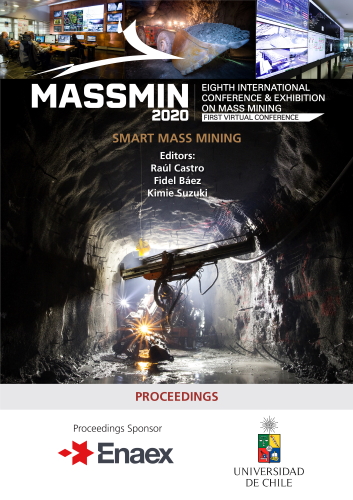Use of Drone based Lidar technology at Olympic Dam Mine and initial Technical Applications

|
Authors: Woolmer, D; Jones, E; Taylor, J; Baylis, C; Kewe, D |
This paper is hosted with the kind permission of Lulea University of Technology, International Conference & Exhibition on Mass Mining, 2024.
DOI https://doi.org/10.36487/ACG_repo/2063_38
Cite As:
Woolmer, D, Jones, E, Taylor, J, Baylis, C & Kewe, D 2020, 'Use of Drone based Lidar technology at Olympic Dam Mine and initial Technical Applications', in R Castro, F Báez & K Suzuki (eds), MassMin 2020: Proceedings of the Eighth International Conference & Exhibition on Mass Mining, University of Chile, Santiago, pp. 565-582, https://doi.org/10.36487/ACG_repo/2063_38
Abstract:
Olympic Dam Mine is a copper, uranium, gold and silver mine located 560 km north of Adelaide, South Australia. The orebody sits beneath approximately 300 metres of a surface, sedimentary sequence and extends to over 2,000 metres in some of the southern areas. The mining method utilized is sub-level open stoping (SLOS) with variable stope sizes and geometries depending on localised mineralization and ground conditions. Obtaining accurate stope survey data is a key part of managing material risks and planning inputs at Olympic Dam. Conventional stope survey methods are subject to issues such as resources required and variable data quality, leading to delays in the production cycle. This process has been improved by the implementation of Emesent’s Hovermap drone autonomy and mobile LiDAR mapping payload. This paper provides a 12-month review describing how Olympic Dam has implemented the technology. It explains the process of training underground personnel to become skilled pilots and flights and scans are scheduled into operations. The results of using this new technology are then compared to traditional survey methods in regards to implementation, output quality and safety. The paper then discusses in detail the applications that the Mine Technical Services Department (Survey, Geotechnical, Geology and Mine Scheduling) are using the data to improve knowledge of the mine and implement efficiencies. The additional data provided has been used by the Technical Services team to refine structural models and actively analyse future stope designs in new mining areas. The introduction of drones, big-data and point-clouds have all been challenges as they are outside the norm for the operation. However, once overcome the benefits from this type of technology and the data it generates is proving to be invaluable for improving safety, time efficiencies and understanding of the rock mass that is feeding into the downstream mining processes.
References:
Clark, J 2020, ‘Geotech teaching talk—Leapfrog update & geological insights’, BHP. Roxby Downs - Olympic Dam, Internal publication.
Jones, E, Reardon, D & Hrabar, S 2019. ‘The use of automated drones in underground hard rock mines’, Proc. Future Mining 2019, The Australasian Institute of Mining and Metallurgy, Melbourne, pp. 34–46.
Matthews, KE, Hoek, E, Wyllie, DC & Stewart, S 1981, ‘Prediction of stable excavation spans for mining at depths below 1,000 metres in hard rock’, Golder Associates, CANMET Library & Documentation Services Division, Vancouver.
Potvin, Y 1988, ‘Empirical open stope design in Canada’ PhD thesis, University of British Columbia.
Taylor, JR, Clark, JM & Levy, I. 2019. ‘BHP Olympic Dam’s Transformation to Live Implicit Modelling and Innovative Solutions to Working in Data Dense Environments’, Proc. Mining Geology Conference, Perth, 25-26 November, 2019, The Australasian Institute of Mining and Metallurgy: Melbourne.
Widdup H, Fouet T, Hodgkison J, McCuaig T C & Miller J 2004, ‘A three dimensional structural interpretation of the Olympic Dam deposit - Implications for mine planning and exploration’, Hi Tech and World Competitive Mineral Success Stories Around the Pacific Rim, Proc. Pacrim 2004 Conference, Adelaide, 19-22 September, 2004, The Australasian Institute of Mining and Metallurgy: Melbourne, pp. 417-426
© Copyright 2025, Australian Centre for Geomechanics (ACG), The University of Western Australia. All rights reserved.
View copyright/legal information
Please direct any queries or error reports to repository-acg@uwa.edu.au
View copyright/legal information
Please direct any queries or error reports to repository-acg@uwa.edu.au
